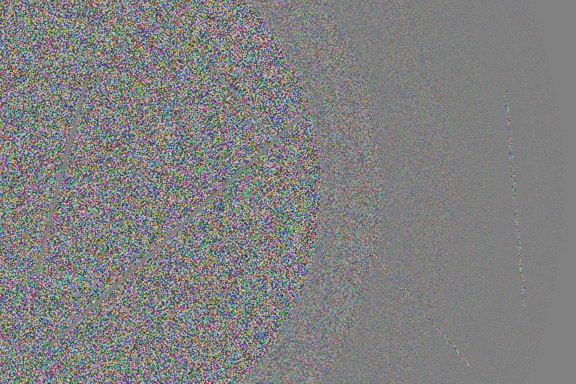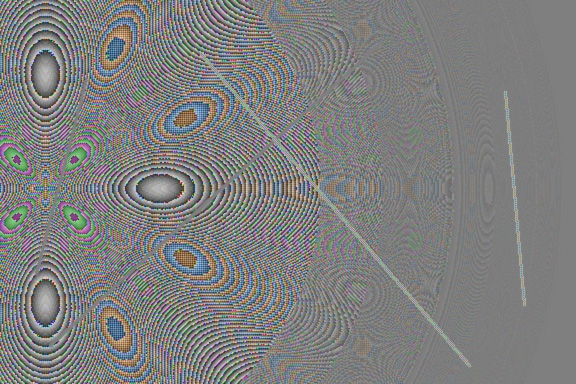You noticed the "too" in Illiah's response, right? From the very beginning of the discussion, Iliah said this was an issue of subject, color management, exposure, and sensor. He added the polarizer as a fifth contributor after he was made aware of it.
It would be correct to assume that, given the fact that I chose to quote it, I had noticed what it said. To be helpful I will quote the section again:
Statement by other contributor: "This is not posterization issue it is a color management issue ..."
Response from Iliah: "It is posterization issue too all right. When you have as few as 46 levels in the 44-138 range in the red channel - and that is over 1.8 million red pixels - it is too few"
Here is where I think you're (unintentionally) misleading folks, Tim. Prior to any post Iliah made in that thread, he duplicated Lloyd's findings by processing to Adobe RGB. It's not like Lloyd did something special here. He used what Iliah very recently referred to in the other thread as "default color management" (after another member depicted it as "bad color management"). With that full understanding, which was never altered by any subsequent clarification, Iliah stated:
"No, it is a mix of three things, exposure, raw format, and colour management; with colour management adding the most to the perceived damage."
Thank you for that kind understanding, I am flattered not to be accused of intentionally misleading anyone! However I do hope that neither of us is doing so unintentionally either. Regarding Iliah's quote that you have reproduced directly above I think it is in fact true to say that Iliah's subsequent two quotes did in fact offer significant additional drill down detail and clarification. Again: "It is posterization issue too all right. When you have as few as 46 levels in the 44-138 range in the red channel - and that is over 1.8 million red pixels - it is too few"
So I think we can agree that overall and including everything Iliah has so far said publicly that we have both read, he is clear that the RAW file is posterised.
I would also like again to remind you that I have the file, and can play with it in my evil laboratory and look at its EXIF for hours on end whenever I choose.
When that file is opened in Lightroom, it looks horribly posterised.
When that file is opened in C1 it looks horribly posterised.
Let's think about that.
LR uses AdobeRGB for some things but, for display in the Develop Module, it uses ProphotoRGB and, with soft proofing enabled, allows a variety of further colour spaces to be used (simulated in fact)
C1 uses "A very large colour space" (to quote them) which I will assume, since they are not more specific, is at least as large as Adobe RGB and probaly Prophoto but it also offers the possibility of viewing in other spaces.
So before there has been anything non-default done to the file, before any other colour space decisions or actions have been made, the file looks horribly posterised in both programs. Because it is.
Of course different monitors have different gamuts relative to a particular colour space so in effect and by default, anyone who looks at the file on any monitor will have effectively chosen a colour space in which to view it, when they purchased their monitor, which is why I use several, amongst which is an Eizo with 97% of Adobe RGB. From memory, Macbook and Macbook Pro colour spaces cover just under 90% of Adobe RGB. Very few monitors manage to cover 100% and none that I am aware of get anywhere close to Prophoto. So pretty much everyone who sees the file will, without taking any action in C1 or LR to change colour space either to view or to output the file, NOT see the entire range of colours the file contains. In fact, the camera outputs files in an uncalibrated color space unless you shoot JPEG.
In other words, the question of what Lloyd did or did not do on output is entirely moot. Iliah himself has said that the information in the file is posterised and, to clarify, when someone said to him "I don't have access to the original RAW file, but I bet I could make a good looking JPEG from the original file, assuming I didn't go from RAW to ProPhoto to Adobe or sRGB." Iliah replied "Oh yes, with a little painting you can."
I take his response (I have several Russian photographer friends) to be a typically Russian piece of humour, somewhere between gentle sarcasm, gentle mockery and irony, and that it means "Not without resorting to a paintbrush".
Iliah reads this forum, he can certainly correct me if I am wrong about that - but let's not forget that he has already said "It is posterization issue too all right". And yes, I did notice the 'too'.
About that 'too' - what I hope we have established beyond much sensible doubt now is that the file is posterised (and in my view, horribly) BEFORE anything is 'done' to it other than choosing which monitor and reputable RAW converter to open it in. That's where all the stuff about histograms and colour channel comes in, and we can all read that again at our leisure. But the
file itself is posterised.
and
"... converting to Adobe RGB shows exact same issues, while in ProPhoto red channel is much smoother and cleaner"
Certainly true, much smoother and cleaner. But not smooth or clean enough, because as the RawDigger histos show and as Iliah has clearly stated, the file is posterised to the extent that starting with it, no one could make a good looking JPEG out of it without a paintbrush.
The current orthodoxy has become to characterize the A7RII as having a "posterization issue". It should be pointed out that every camera with a Bayer sensor has a "posterization issue". This idea that the A7RII will do this under certain very rare circumstances should be understood in context of the fact that a camera like the D810 might do it under even rarer circumstances, but they all can and will do it when the light captured is of a certain quality and quantity. My first Canon 5D had 12-bit RAW and was one of the most popular cameras in the world. Can't ever recall there being a stir made about posterization.
Yes, thanks for helping point out the quantisations involved in de-bayerisation and most importantly for agreeing that there are indeed circumstances under which the A7RII will do it. We can agree that most, even all, cameras could be subject to it. But in the case we are discussing what we are all trying to understand is whether that is MORE likely to happen with the A7RII camera than with one of its peers, such as the MF cameras, the new Canon, or the Nikon D810/A. In order to do that we need to fully understand what is causing it. Focussing on the colour management issues later in the imaging chain might help explain why it gets horrendous rather than the horrible it started out as, so let's focus on what might be causing it and whether it is more likely to happen with this particular camera than with its peers end even, God forbid, whether there are any shooting habits we can adopt that might ameliorate it. Such as, not using a polariser, or exposing as far to the right as we can, or using a Cyan filter (not for me, that one, I had enough of remedial filters with the M8!) but NONE of this has anything to do with the management of output color space.
A couple questions have not been answered:
1) Would the greater number of red levels in the red channel be enough to completely avoid posterization under these particular capture conditions if the camera offered uncompressed (or loslessly compressed) raw?
2) Iliah noted other gaps in the raw file, which he thinks could be from lens compensation settings. The EXIF shows that Lloyd had lens compensation on. Would the posterization have been different or avoided without lens compensations enabled?
I can't answer the first one but I do subscribe to the 'no free lunch' theory on this, and I do find the files less robust in PP than those from a D810.
The second one, to clarify, the EXIF shows distortion correction: None and Vignetting Correction: OFF. However, Chromatic aberration corrections are set to Auto and, not having the 85mm Batis, I don't know whether the camera allow that setting to be set to off. There are, later in the EXIF, parameters for these CA corrections but I don't know if that means that they were necessarily used - parameters are also given for distortion corrections and we know that that was set to OFF.












